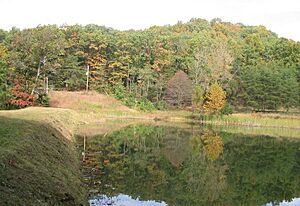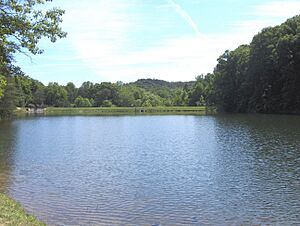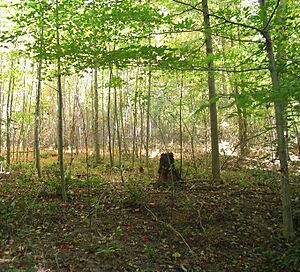Jefferson Memorial Forest facts for kids
The Jefferson Memorial Forest is a huge forest in southwest Louisville, Kentucky. It's part of the Knobs region of Kentucky, known for its unique hills. This amazing forest covers about 6,500 acres (26 km2), making it the biggest urban forest in the entire United States!
This special forest was created to honor Kentucky's veterans, who are people who have served in the armed forces. It's also recognized as a wildlife haven by the National Audubon Society, which means it's a safe place for many animals and plants.
Fun Things to Do in the Forest
The Jefferson Memorial Forest has over 35 miles (50 km) of different hiking trails. Some of these trails even give you cool views of downtown Louisville! The forest has several areas for visitors to enjoy.
One popular spot is the Tom Wallace Recreation Area. Here, you'll find the 7-acre (28,000 m2) Tom Wallace Lake. You can also visit the Paul Yost Recreation Area and the Horine Conference Center.
You can go camping and fishing in the forest. Tom Wallace Lake is stocked with trout and catfish once a year, so there are plenty of fish to catch! The Tom Wallace Recreation Area also has special features for people with disabilities. This includes a fishing dock and a 1,560-foot (480 m)-long natural trail called the Tuliptree Trail. The Horine Conference Center is a favorite place for school field trips from Louisville.
The Louisville Metro Government manages and takes care of the forest.
There's a long hiking trail called the Siltstone Trail that goes across a big part of the forest from east to west. Many other local hiking trails are also available. The Horine area has lots of hiking trails too. Both the Paul Yost and Tom Wallace Recreation Areas offer trails for horses. While mountain biking isn't allowed right now, the quiet roads and hilly areas are great for road cyclists looking for a challenging ride.
A Look Back at the Forest's History
The idea for the Jefferson Memorial Forest started in 1946. Jefferson County, Kentucky, wanted to create a large forest preserve in the southern part of the county. It was first planned to be 10,000 acres (40 km2) big. The forest was named to remember those from the area who died in World War II. Later, its name was changed to honor everyone who has served in the armed forces.
Paul Yost was the first county forester, and he helped buy the first pieces of land. By 1954, about 1,300 acres (5.3 km2) had been bought. More land was added slowly over the years. By the mid-1980s, the forest had grown to about 5,000 acres (20 km2). Since then, more land has been added little by little.
In the late 1990s, the old ranger station, which used to be a country schoolhouse, was updated. It became a visitor and welcome center for everyone to enjoy.
On May 30, 2004, some parts of the park were affected by a tornado. This caused several trails to be closed for a while.
Nature's Wonders in the Forest
The forest is home to about fifty different kinds of trees, including ten types of oaks! You can also find many beautiful wildflowers and seventeen different kinds of ferns. A wide variety of animals live here too. Keep an eye out for bobcats, coyotes, red foxes, white-tailed deer, tall great blue herons, and wise horned owls.
Like many natural areas in the eastern United States, the forest faces a challenge with certain plants that aren't native to the area. These "invasive" plants can sometimes take over. Some examples include tree-of-heaven, autumn olive, Amur honeysuckle, Japanese honeysuckle, and princess tree.
The forest is located in Kentucky's Knobs region, also known as the Muldraugh Escarpment. This area has rugged hills between the Bluegrass and Pennyrile regions. The hills are mostly made of siltstone and shale. The siltstone creates very steep hillsides, like Holsclaw Hill, which gives its name to the important Holtzclaw Siltstone found in the forest.






